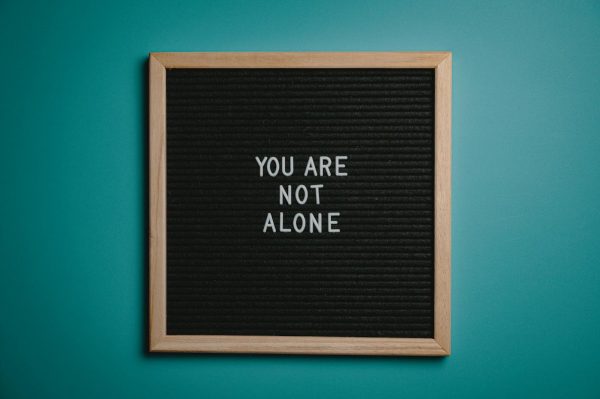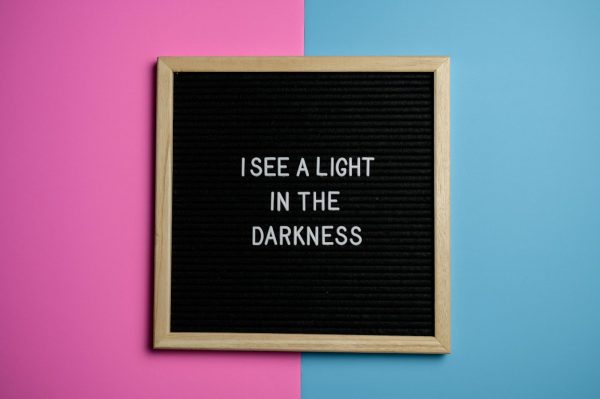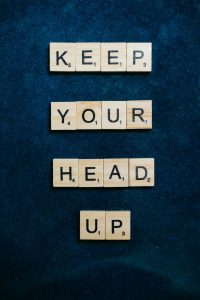| Written by Jessica Lelinho, MA, LPC, NCC, LCADC, C-DBT
We all probably know the saying April showers bring May flowers. May is finally here and it’s not so gloomy outside – the sun is shining, kids are outside playing, birds are chirping. We’re supposed to feel happy but we don’t always feel that way – you’re tired of being judged or labeled or discriminated against because of your mental health. It’s time to bring awareness about mental health and to stomp out the stigma associated with mental illness.

What is Mental Health?
The American Psychological Association defines mental health as a state of mind characterized by emotional well-being, good behavioral adjustment, relative freedom from anxiety and disabling symptoms, and a capacity to establish constructive relationships and cope with the ordinary demands and stresses of life.
Types of Mental Health Diagnoses
When we think of mental health, we think of common diagnoses, however, the Cleveland Clinic states that there are more than 200 types of mental health disorders. Most of the common ones include:
- Anxiety Disorders
- Attention-Deficit/Hyperactivity Disorder (ADD/ADHD)
- Autism Spectrum Disorder
- Depression, bipolar disorder, and other mood disorders
- Disruptive behavioral disorders, such as oppositional defiant disorder and conduct disorder
- Eating disorders
- Obsessive compulsive disorder (OCD)
- Personality disorders, including borderline personality disorder and antisocial personality disorder
- Post-traumatic stress disorder (PTSD)
- Schizophrenia and other psychotic disorders
- Substance use disorders, including drug addiction and alcohol use disorder
Common Mental Health Diagnoses Across Ages
Individuals of any age, sex, ethnicity, or background can be afflicted with a mental health disorder. Mental health disorders can affect children (3 years old – 12 years old), adolescents (13 years old – 18 years old), adults (18 years old – 64 years old) and geriatrics (65 years and older).
The CDC identifies the common mental health diagnoses for children to include: Anxiety, Depression, Oppositional Defiant Disorder (ODD), Conduct Disorder (CD), Attention-Deficit/Hyperactity Disorder (ADD/ADHD), Tourette Syndrome, Obsessive-Compulsive Disorder (OCD), Post-traumatic Stress Disorder (PTSD), and other related conditions.
The World Health Organization identified common mental health disorders of adolescents to be: emotional disorders (anxiety, panic, and depressive disorders), behavioral disorders (Attention-Deficit/Hyperactivity Disorder(ADHD) and Conduct Disorder), eating disorders (anorexia nervosa and bulimia nervosa), psychosis, suicide and self-harm, and risk taking behaviors (substance use, sexual risk-taking, alcohol usage, tobacco usage, and marijuana usage).
Adults can be afflicted with the same mental health disorders as children and adolescents. HealthyPlace identifies Adult Mental Health Symptoms for various mental health disorders including: adjustment disorder, ADD/ADHD, Agoraphobia, Alcohol Abuse/Substance Abuse, Alzheimer’s Disease, Anorexia Nervosa, Anxiety Disorders, Autism Spectrum Disorder, Bipolar Disorder, Bulimia Nervosa, Cyclothymia Disorder, Delusional Disorder, Dementia (Alcoholic, Alzheimer’s Type), Depression, Dysthymia, Eating Disorders, Generalized Anxiety Disorder, Major Depressive Disorder, Obsessive-Compulsive Disorder, Panic Disorder, Post-traumatic Stress Disorder (PTSD), Schizoaffective Disorder, Schizophrenia, Separation Anxiety Disorder, Social Phobia, Specific Phobia, Substance Abuse, and Tourette’s Syndrome.
The CDC identified the common mental health disorders of geriatrics to be: depression and anxiety. The National Library of Medicine identified additional mental health disorders of geriatrics include: delirium and dementia.
Statistics on Mental Health
The CDC provides the following statistics regarding mental health:
- More than 1 in 5 US adults live with a mental illness.
- Over 1 in 5 youth (ages 13-18) either currently or at some point during their life, have had a seriously debilitating mental illness.
- About 1 in 25 U.S. adults live with a serious mental illness, such as schizophrenia, bipolar disorder, or major depression.
The Cleveland Clinic provided the following statistics regarding mental health:
- About 1 in 5 adults and adolescents live with a mental health disorder.
- About half of all mental illnesses begin by age 14 and three-quarters begin by age 24.
- Suicide, which is often associated with mental illness, is the 10th leading cause of death in the U.S. and is the second leading cause of death among people ages 15 to 34.
John Hopkins Medicine provided the following statistics regarding mental health:
- Mental health disorders account for several of the top causes of disability in established market economies, such as the U.S., worldwide and include: major depression (also called clinical depression), manic depression (also called bipolar disorder), schizophrenia, and obsessive-compulsive disorder.
- An estimated 26% of Americans ages 18 and older – – about 1 in 4 adults – – suffers from a diagnosable mental disorder in a given year.
- Many people suffer from more than one mental disorder at a given time. In particular, depressive illnesses tend to co-occur with substance use and anxiety disorders.
- Approximately 9.5% of American adults ages 18 and over, will suffer from a depressive illness (major depression, bipolar disorder, or dysthymia) each year.
- Women are nearly twice as likely to suffer from major depression than men. However, men and women are equally likely to develop bipolar disorder.
- While major depression can develop at any age, the average age at onset is the mid-20s.
- With bipolar disorder, which affects approximately 2.6% of Americans age 18 and older in a given year — the average age at onset for a first manic episode is during the early 20s.
- Most people who commit suicide have a diagnosable mental disorder — most commonly a depressive disorder or a substance use disorder.
- Four times as many men than women commit suicide. However, women attempt suicide more often than men.
- The highest suicide rates in the U.S. are found in Caucasian men over age 85. However, suicide is also one of the leading causes of death in adolescents and adults ages 15 to 24.
- Approximately 1% of Americans are affected by schizophrenia.
- In most cases, schizophrenia first appears in men during their late teens or early 20s. In women, schizophrenia often first appears during their 20s or early 30s.
- Approximately 18% of people ages 18- 54 have an anxiety disorder in a given year. Anxiety disorders include: panic disorder, obsessive-compulsive disorder (OCD), post-traumatic stress disorder (PTSD), generalized anxiety disorder (GAD), and phobias (social phobia, agoraphobia, and specific phobia).
- Panic disorder typically develops in late adolescence or early adulthood.
- The first symptoms of OCD often begin during childhood or adolescence.
- GAD can begin at any time, though the risk is highest between childhood and middle age.
- Individuals with OCD frequently can have problems with substance use or depressive or eating disorders.
- Social phobia typically begins in childhood or adolescence.
Additional statistics regarding mental health can be found on the National Alliance on Mental Illness (NAMI) website.

Causes of Mental Illness
There is not one single cause of mental health illnesses as various factors can all contribute. The CDC and the Cleveland Clinic identified the following factors to contribute to mental illness:
- Adverse Childhood Experiences such as trauma or a history of abuse (child abuse, sexual assault, witnessing violence, etc.)
- Experiences related to other ongoing (chronic) medical conditions, such as cancer or diabetes or hypothyroidism
- Biological factors or chemical imbalances in the brain
- Use of alcohol or drugs
- Having feelings of loneliness or isolation
- Lack of proper nutrition
- Lack of a support system consisting of family and/or friends
- Having a traumatic birth or born from a high-risk pregnancy
- Family history of behavioral health disorders
- Having a neurological disorder such as Alzheimer’s Disease or Dementia
- Having a sleep disorder
- Stress
- Having a traumatic brain injury (TBI)
- Struggling with spirituality or beliefs
Diagnosing Mental Health Disorders
The Cleveland Clinic acknowledges the importance of getting a diagnosis from a healthcare provider who specializes in behavioral health disorders; an accurate diagnosis is needed to receive the proper treatment. The healthcare provider will review your symptoms to evaluate your mental health. It’s important to tell your healthcare provider:
- If there are any specific triggers that make your mental health worse,
- If your mental health problems are chronic (ongoing) or if they come and go, and
- When you first noticed changes in your mental health.
While there aren’t any medical tests that can diagnose mental health illnesses, your healthcare provider may perform tests, such as blood work or imaging exams to rule out other conditions that could possibly be contributing factors.
Mental Health Treatment
Many individuals diagnosed with a mental health condition achieve strength and recovery by participation in individual or group treatment. Mental Health America (MHA) discuss different treatment options including:
- Psychotherapy
- Medication
- Case Management
- Hospitalization
- Support Group
- Complementary & Alternative Medicine
- Self Help Plan
- Peer Support
- Other treatments such as electroconvulsive therapy (ECT) or art therapy
How Do I Choose Between Medication and Therapy?
While there are various different types of treatment, there is no “one size fits all” – each individual will need to determine the best treatment for themselves. The American Psychological Association (APA) discusses that medications, psychotherapy, and their combination have been shown to best treat individuals with emotional or behavioral concerns. It’s important to know that different types of problems will respond differently to various treatments.

Benefits of Mental Health Treatment
Substance Abuse and Mental Health Services Administration (SAMHSA) discusses the benefits of mental health treatment including but not limited to:
- Management of your illness
- Overcoming challenges
- Productive lives
Additional benefits of mental health treatment include:
- Improvements or improved relationships
- Development of wellness goals
- Improved health outcomes
- Better performance at school or work
- Encouragement or assistance
- Increased self-awareness
- Resolving conflict
- Communication
- Problem solving
- Building resilience and development of coping skills
- Getting through a crisis
- Reduced chance for complications
- Development of a support system(s)
- Healing trauma and pain
- Ability to manage stress more effectively
- Symptom Reduction
Stigmas Associated with Mental Health
While mental health illnesses have begun to be de-stigmatized, unfortunately, stigma is still out there and many individuals do not wish to seek help with their mental health due to the stigma or even being labeled.
The American Psychiatry Association reported that more than half of people with mental illness don’t receive help or treatment for their disorders. Oftentimes, individuals avoid or delay treatment due to concerns about being treated differently, fears of losing their jobs, or fears of losing their livelihood due to the stigma, prejudice, and discrimination against individuals afflicted with mental illness. It’s said that often the stigma comes from a lack of understanding or fear or even inaccurate or misleading media representations of mental illness. Reviews of studies on stigma show that while the public may accept the medical or genetic nature of a mental health disorder and the need for treatment, many people still have a negative view of individuals afflicted with mental illness. Researchers identified the following types of stigma:
- Public stigma which involves the negative or discriminatory attitudes that others may have about mental illness
- Self stigma refers to the negative attitudes, including internalized shame, that people with mental illness may have about their own condition(s)
- Structural stigma is more systemic, involving policies of government and private organizations that intentionally or unintentionally limit opportunities for people with mental illness. Examples include lower funding for mental illness research or fewer mental health services relative to other care.
The stigma associated with mental illness not only affects the individual afflicted with mental illness but also their loved ones who are supporting them, oftentimes including family members.
The chart below displays the type of stigma pertaining to stereotypes & prejudices with discrimination.
| Public | Self | Structural | |
| Stereotypes & Prejudices | People with mental illness are dangerous, incompetent, to blame for their disorder, unpredictable | I am dangerous, incompetent, to blame | Stereotypes are embodied in laws and other institutions |
| Discrimination | Therefore, employers may not hire them, landlords may not rent to them, the health care system may offer a lower standard of care | These thoughts may lead to lowered self-esteem and self-efficacy: “Why try? Someone like me is not worthy, or unable to work, live independently, or have good health” | Leads to intended and unintended loss of opportunity |
The harmful effects of stigma and discrimination have been studied and research has shown that self-stigma leads to negative effects on recovery among people diagnosed with severe mental illnesses. Effects can include:
- Reduced hope
- Lower self-esteem
- Increased psychiatric symptoms
- Difficulties with social relationships
- Reduced likelihood of staying with treatment
- More difficulties at work
Other harmful effects of stigma include:
- reluctance to seek help or treatment and reduced likelihood of staying with treatment
- Social isolation
- Lack of understanding by family, friends, coworkers, or others
- Fewer opportunities for work, school or social activities or trouble finding housing
- Bullying, physical violence or harassment
- Health insurance that doesn’t adequately cover your mental illness treatment
- The belief that you’ll never succeed at certain challenges or that you can’t improve your situation

Stigmas about mental illness can also impact family and friends, diverse communities, and the workplace. A 2022 national poll from the American Psychiatric Association (APA) found that mental health stigma is still a major challenge in the work environment.
- About half (48%) of workers say they can openly and honestly discuss mental health with their supervisor. This was down from 56% in 2021 and 62% in 2020.
- Half (52%) say they feel comfortable using mental health services with their current employer in comparison to 64% in 2021 and 67% in 2020.
- Fewer adults are worried about retaliation if they take time off or seek mental health care. About one in three (36%) worried about retaliation if they took time off in comparison to 48% in 2021 and 52% in 2020.
- Less than one third (31%) were worried about retaliation for seeking care when compared to 43% in 2021 and 2020.
How Can We Reduce Stigma Associated with Mental Illness?
Many years of research on anti-stigma interventions has found that successful interventions from a public approach:
- Include contact (in person but video can also be a feature if done right)
- Focus on a range of disorders, not just depression or mental illness broadly
- Involve participation with people with a “lived experience”
- Target groups that have the most interaction or where lack of help-seeking is most problematic (e.g., young people, undocumented communities, military communities)
- Are tailored to be credible to specific language and cultural signifiers of the target group
- Last several years to be effective
The National Alliance on Mental Illness (NAMI) offer the following suggestions of how individuals can reduce stigma:
- Talk openly about mental health, such as sharing on social media
- Educate yourself and others – respond to misperceptions or negative comments by sharing facts or experiences
- Be conscious of language – remind people that words matter
- Encourage equality between physical and mental illness – draw comparisons to how they would treat someone with cancer or diabetes
- Show compassion for those with mental illness
- Be honest about treatment – normalize health treatment, just like other health care treatment
- Let the media know when they are using stigmatizing language presenting stories of mental illness in a stigmatizing way
- Choose empowerment over shame – “I fight stigma by choosing to live an empowered life. To me, that means owning my life and my story and refusing to allow others to dictate how I view myself or how I feel about myself” – Val Fletcher
Employers who are leading efforts to address stigma offer the following advice:
- Tailor programs/approaches to your company culture
- Mention your commitment to leading a behaviorally healthy workplace every time you mention the company’s commitment to its overall culture of health, attracting and retaining the best talent, and valuing its employees, etc.
- Train leaders to identify emotional distress and make referrals responding promptly and constructively to behavioral performance issues
- Be welcoming of the need for accommodations. Train managers to respond appropriately.
If you are in crisis, or you know someone who is in crisis, contact the 988 Suicide & Crisis Lifeline or dial 911 in case of emergency.
- Call or text 988
- Chat 988lifeline.org
- TTY users, use your preferred relay service or dial 711 then 988
Mental health diagnoses are more prevalent than one would think. Unfortunately, barriers to treatment or even misconceptions or stigma stop individuals from getting the help they need. This post is to make awareness about mental health and diagnoses, the stigmas associated with mental health and how to combat the stigmatization of mental health in addition to providing resources for those afflicted with mental health illnesses.
If you are looking to address mental health, don’t hesitate to reach out for help. Addressing your mental health can lead to decreasing mental health symptoms, result in de-stigmatization, provide you with the tools to overcome mental illness, and provide support. A licensed professional can assist you in overcoming these challenges.
When Jessica is not providing therapy, she enjoys spending time with her family and friends, listening to country music, cooking, baking, and going to the beach.
Check out Jessica’s professional bio here
Email Us: info@exceptionalwellnesscounseling.com
Call Now: (908) 415-2042
NEXT STEPS & RESOURCES
- Are you ready to take your first step? Reach out to us.
-
General Mental Health Resources
- Mental Health America: provides information on mental health, getting help, and taking action
- National Council for Mental Wellbeing: locate mental health and addiction treatment facilities in your community
- National Empowerment Center: Carry a message of recovery, empowerment, hope, and healing to those afflicted with mental illness and provide information and advocacy resources
- National Institute of Mental Health (Mental Illness Among U.S. Adults): provides prevalence statistics pertaining to mental illness data by age, gender, and race
- President’s New Freedom Commission on Mental Health: Commission report to eliminate inequality for Americans with disabilities
- World Health Organization (WHO): provides information on global burden of disease in various parts of the world including the burden due to mental illness
- National Alliance on Mental Illness (NAMI): Non-profit, grassroots, self-help, support, and advocacy organization of individuals with mental health disorders and their families.
Depression and Suicidal Ideations
- American Association of Suicidology
- American Foundation for Suicide Prevention (AFSP)
- Brain & Behavior Resource Foundation
- Mental Health America: screening tools for information on mental health, getting help, and taking action
- Depression Screening
- MoodGYM
- Postpartum Support International (PSI)
- Suicide Prevention Resource Center
Non-Suicidal Self-Injury
Anxiety Disorders
Psychosis and Psychotic Disorders
Substance Use Disorders
- Centers for Disease Control and Prevention (Smokefree.gov)
- National Council on Alcoholism and Drug Dependence, Inc.
- National Institute on Alcohol Abuse and Alcoholism
- Start Your Recovery
- National Institute on Drug Abuse (NIDA)
- Substance Abuse & Mental Health Services Administration
- Drug Screening
- Alcohol Screening
Eating Disorders
- National Association of Anorexia Nervosa and Associated Disorders (ANAD)
- National Eating Disorders Association
- National Institute of Mental Health (NIMH)
Help Lines
- American Psychiatric Association Answer Center: 1-888-35-PSYCH (77924)
- American Psychological Association of Public Education Line: 1-800-964-2000
- National Suicide Prevention Lifeline: 988
- The Trevor Project: 1-866-488-7386
- National Cancer Institute Smoking Line: 1-877-44U-QUIT (1-877-448-7878)
- Smoking Cessation Centers: 1-800-QUIT-NOW (1-800-784-8669)
Support Groups
- Al-Anon and Alateen
- American Self-Help Group Clearinghouse
- Depression and Bipolar Support Alliance (DBSA)
- Eating Disorders Anonymous
- Narcotics Anonymous (NA) and Alcoholics Anonymous (AA)
- Overeaters Anonymous (OA)
- Recovery International
- Schizophrenia and Related Disorders Alliance of America (Schizophrenics Anonymous)

